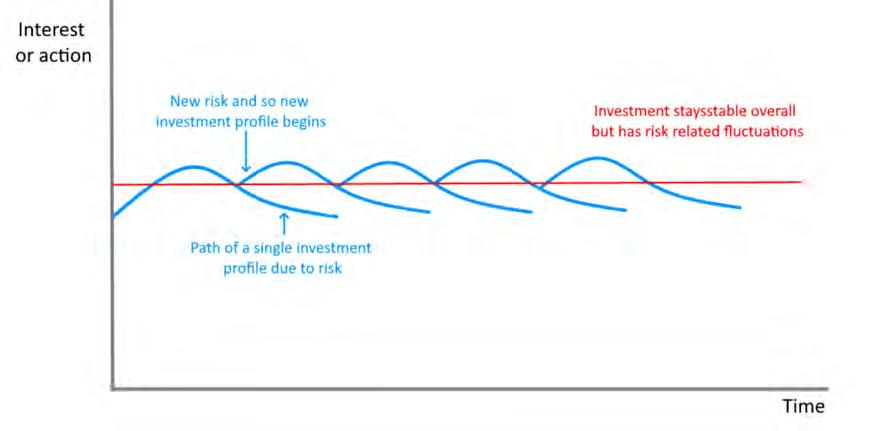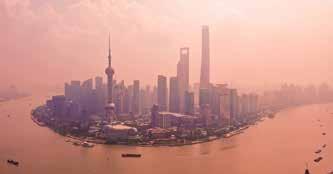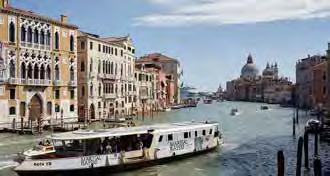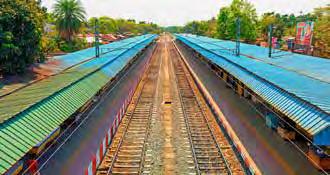
16 minute read
Risks, events, and threats to infrastructure investment
What is the current risk status when considering infrastructure?
Companies are used to managing various risks such as market changes, financial, personnel and skills, economic, political/governmental, technological including cyber security, regulatory/policy changes and significantly in recent times as shown by the Covid-19 pandemic, health and operational risks.
The shifting of risks between the various challenges does not negate or mean that risks completely disappear. For example, environmental risks including climate change, severe weather conditions such as flooding, droughts, natural/forest fires etc have not ceased due to Covid becoming more important or prevalent.
Such risks are also important for infrastructure investment in several ways, for example:
• Infrastructure investment generally takes significant time to propose, plan and gain private/political/ government sign off and then design and deliver and so regardless of the delivery mechanism (public or private) the stability of the investment environment is important.
• To price and attract investment in infrastructure an understanding is required of the risks both within the project and in the wider economic/social/political environment. For example, demand risk if not understood correctly leads to a sub-optimal outcome for investments.
• Infrastructure investment embeds a relatively static way of operating in the short term. For example, no economy will just stop using railways overnight. Whilst there is some short-term flexibility most changes/ adaptations would occur over the medium and long term, so it is important that investment decisions are made efficiently and sustainably.
• Infrastructure is a means of addressing and mitigating several risks that affect companies, governments, society and the economy. For example, the Covid crisis has highlighted the fragility of health and remote working infrastructure (such as broadband) in many countries.
• Social and economic activity and the productivity of capital and labour are linked to the quality of infrastructure.
The above, in combination with the previously outlined evidence that countries are not spending enough to maintain their current status quo let alone meet the SDGs going forward suggests that the investment environment needs to be considered in more detail. To do this we draw evidence from 2 key reports by the World Economic Forum.
One was published pre-Covid and the second presents their preliminary findings on risks during Covid and as economies plan to exit the crisis. The shift in perceptions is not only interesting but has significant implications.

The first report we consider (the pre-Covid position) is a report produced annually by the World Economic Forum in their Global Risks Reportxii. The latest 2020 report reveals that the top five global risks in terms of likelihood are:
• Extreme weather
• Climate action failure
• Natural disasters
• Biodiversity loss
• Human-made environmental disasters
It is interesting to note that this is the first time since 2007 that the top five risks have all been in the environmental category. This demonstrates why initiatives such as the Sustainable Development Goals and ensuring engineering solutions are sustainable and resilient is so important.
It is also worth noting that since 2015 no economic factors have been considered in the top five global risks. Whilst there is some rationale to this, for example they featured heavily as the top global risks in recessionary periods but slowly fade away as economic conditions improve, it is interesting to consider their absence considering the investment that would be required to address such climate/environmental risks. Having said this, 78% of respondents were still expecting economic confrontations to increase in 2020, which could disrupt and create further uncertainly putting pressure on investment.
Looking at the top five risks in terms of impact the report rates the risks as follows:
• Climate change action
• Weapons of mass destruction
• Biodiversity loss
• Extreme weather
• Water crisis
Interestingly, three of the risks are not only likely but have a severe impact and that a water crisis is also now considered one of the top five, an issue that was raised in FIDIC’s 2015 State of the World report and still features heavily in the 2020-2021 State of the World series due to its significance and importance for food, water, energy production and the environment.
The report also reveals that amongst the multi-stakeholder and global shapers (the Global Shapers Community is the World Economic Forum’s network of young people) surveyed, the majority expected risks across a wide range of categories to rise in 2020 and whilst there were some differences from the overall result, the environment featured heavily across both sets of respondents.
Whilst not in the top five risks, both sets of respondents also identified cyber-related issues, such as cyber-attacks and data fraud or theft, in the list of top ten long-term risks.
The above demonstrates that the environmental, technological and infrastructure solutions are important to addressing the majority of global needs.

Covid has changed everything
Global uncertainty about the future is increasing. Indeed, the IMF’s World Uncertainty Indexxiii, which covers 143 countries around the world with a population of at least two million, has now reached record levels. During the global financial crisis of 2009, the index was 340. The Iraq war saw it rise to 550 while the Covid-19 crisis has seen it rocket up to 820 – an all-time high.
This is reflected as you fast forward to May 2020 and the World Economic Forum’s release of Covid-19 Risks Outlook A Preliminary Mapping and Its Implicationsxiv report. It is fair to say the concerns and risks from respondents highlighted paint a very different picture.
This time, the report explores the most likely fallout and risks of greatest concern. Looking at the top five global risks in terms of fallout there were:
• Prolonged recession of the global economy.
• Surge in bankruptcies (big firms and SMEs) and a wave of industry consolidation.
• Failure of industries or sectors in certain countries to properly recover.
• High levels of structural unemployment (especially youth).
• Tighter restrictions on the cross-border movement of people and goods.
And the top five in terms of greatest concern were:
• Prolonged recession of the global economy.
• High levels of structural unemployment (especially youth).
• Another global outbreak of Covid-19 or different infectious disease.
• Weakening of fiscal positions in major economies.
• Failure of industries or sectors in certain countries to properly recover.
To say there has been a significant shift is an understatement. In less than half a year, rather than being focussed on environmental risks, eight of the top ten most likely fallouts and concerns and risks are now economic.
The first environmental risk on both lists is now a higher risk of failing to invest enough in climate resilience and adaptation and features at 19th on the fallout list and 23rd on the list of concerns.
The report also clearly states:
“Pandemics have traditionally suffered from a panic–neglect cycle. Quiet periods see no action, early warnings of an outbreak tend to be overlooked, significant response and funding are late and uncoordinated, and valuable lessons from the crisis are not institutionalised.” xv
This is another aspect governments will need to consider, as they strive to develop lessons learnt from the first global pandemic for approximately 100 years, which has affected the majority of countries. These lessons will inevitably factor into investment plans including those for infrastructure going forward.
What do risk and events such as Covid mean for infrastructure investment?
The shifting of risks towards those of economic-related issues, whilst significant as part of the Covid crisis, is not surprising. Such shifts have occurred within and during the period preceding previous recessions. Given the likelihood that Covid has reduced economic activity to the point it may trigger the next recession, it is natural for individuals, companies, and governments to react to such circumstances.
Looking forward, our reaction to this crisis will determine not only our future resilience to COVID type events but also the mix of risks that infrastructure investment faces are not only short term in nature.
To demonstrate this, let us consider for a moment what happens within the process of identifying and reacting to risks more generally.
As can be seen from Figure 6 below, the red line represents the emergence of a new risk, which emerges and reaches a peak then tails off. The response socially, individually or by governments etc, then lags the emergence of the risk and in this example the interest or action is proportional to the risk. In an ideal scenario you could argue that the response should be proportionate to the risk, but this may not always be the case. We use an example where it is for ease.
You then get the reactive spending which follows the reaction. This is because whilst individuals and policy will adapt, there will be a further lag until such spending, behaviour etc, takes place.
Reactive spending, however, is generally short term (e.g. in a recession it might be unemployment payments) but this spending does not constitute the full response to the risk that has emerged. The blue line shows the investment spending that then occurs over a longer period and is a result of lessons learnt or systematic failures to address the risk that occurred.
Figure: 6 – Illustrative risk response

Then there is the scenario that has not yet been discussed and potentially will change the investment landscape for infrastructure in a way that has not yet been considered, at least in the short to medium term. The Covid-19 reactionary expenditure, which to date it is fair to surmise is more significant than any economic crisis in the last 100 years, will have an effect going forward.
The rationale for this paper separating out the Covid-19 reaction compared to the generic risk profile is due to several factors which include:
• The scale of the shock to the global economy has been unprecedented with most industries and economies hit simultaneously.
• Global stimulus efforts to respond to the virus have been unprecedented in scale and most countries in a survey by the OECD have focused on relief measures rather than investment. For example, of the 109 countries the policy focus was on personal income tax (53%), Corporate income tax (66%), VAT (54%) and social security (36%)xvi .
• Investment measures are being talked about but there will be a financing challenge given the unprecedented scale of the short-term measures that were put in place.
To put the scale of this short-term response in context, if we look at some of the economic figures to date and some early comparisons to the previous financial crisis, it is revealed that:
According to the UN’s trade and development agency - the slowdown caused by Covid-19 is likely to cost at least $1 trillion, however, the doomsday scenario in which the world economy grew at only 0.5%, would involve a $2 trillion hit to GDPxvii .
According to the UN, rich industrial nations have already announced a $5 trillion global rescue package plan but a $2.5 trillion Covid-19 rescue package is needed for world’s emerging economiesxviii .
Central banks have moved far quicker than they did in the financial crisisxix. This should help to provide financial resources available to businesses on terms that are acceptable/achievable compared with the situation which plagued plagued the years following the financial crisis. Governments have moved to support such schemes.
Using the UK as an example, it was recently revealedxx that the deficit is due to potentially hit £337bn in the current year as the ‘base case scenario’. That is the equivalent to 17% of GDP and is significantly above the £158bn (10.2% of GDP) that occurred in the financial crisis in 2009/10. This sort of projection is not unique to the UK, with many countries facing unprecedented rises in short-term and immediate spending in response to Covid-19.
As such, it is reasonable to assume that the Covid-19 response curve has occurred relatively faster and at a more intense extent to the normal response curve. Before we consider the potential investment profile out of Covid, let’s first look in a bit more detail at purely the investment curve that occurs because of risks/events.

So far, governments have had to make decisions that most would agree have been appropriate in focusing on short-term spending, but they now need to begin to consider long-term investment, both as a way out of the economic crisis that is emerging but also to prepare for and counter the next crisis. Without this investment we also risk losing track of our commitments on SDGs.
The economic cycle, repeated risks and the investment curve
To understand the response investment response to the economic cycle and risks better, below we consider two scenarios.
The first in Figure 7 shows the investment curve that occurs due to a risk/event that is repeated at equal intervals and so it would allow society/government to plan its investment profile out of such crisis to create an overall stable position going forward.
There are, however, several issues with describing the investment profile in this manner, such as:
• It is unlikely that risks/events are going to occur at equally spaced intervals.
• It assumes that when making investments society/governments are aware of what the ‘right’ level of investment should be over the longer term.
• Currently it considers ‘investment’ as a whole whereas each investment curve will be a combination of many investments and so no two curves will be the same.
• It ignores economic conditions.
Figure 7 - Stability over the long run

Taking the last of these you could consider the profile in a similar way where individual risks/events result in investment profiles that follow an economic cycle. As such, you would end up with something that resembles the profile outlined in Figure 8.
As can be seen, whilst you now have a ‘combined overall’ risk profile it now also tracks economic conditions. Whilst this does not have the constant level of stability of the scenario above, it should better represent the reality of investment decisions that are made.
Figure 8 - Economic cycle

Having said the above, if you consider that government investment can be used as a stimulus tool and that there will be a lag between the economic cycle and the response and so investment cycle, you will end up with something like the red line for the overall investment profile tracking several periods behind the economic cycle. Over the long term, however, the investment curve even with government expenditure falling out of line with the economic cycle would to some extent follow the profile, given that investments made in times where stimuli are needed would need to be followed by times of lower investment when stimuli are not as necessary.
The above, however, does not yet account for the differential between short and long-term risk/events. Currently each of the investment curves are treated equally and so therefore in theory have an equal standing.
Below, if you look at only the aggregate positions, you can see that there will be many aggregate investment curves for each type of investment which, when combined, create the overall aggregated position.
Figure 9 - Economic cycle, multiple investment profiles generate the aggregate

This is where it is important for individuals, society, companies and governments to prioritise the type of investments they are undertaking over time.
As is shown below in Figure 10, investment profiles that were previously considered important/essential as a result of risks/events can over time shift from being an important investment to a less important one – e.g., from above the aggregate position to below it and vice versa.
The nexus point of this shift is demonstrated by the yellow circle as one investment preference rises and one declines. Whilst the example below shows the trade-off between two investment decisions, there will be many of these decisions occurring simultaneously to produce the aggregate outcome.
Figure 10 – Switching investment priorities

This is where the current Covid crisis and the current views on global risks which were discussed previously are important, as the balance and shift in investment decisions is already occurring.
Since the financial crisis in 2007/08, there has not been a crisis serious enough to warrant a wholesale economic stimulus. Covid-19 is therefore not only one of the greatest health risks the globe has faced in the last century, but has the potential to be one of the most severe economic challenges the world has ever faced.
As the Covid crisis took hold it was understandable that emphasis was on combatting the spread of the virus. Whilst these concerns still exist, the gradual shift towards that of short/medium run economic concerns is understandable given the scale of the economic support packages that have been announced around the globe.
This should not, however, mean that investment in infrastructure that meet the environment concerns and the risks identified less than six months previously should not continue to be prioritised in terms of the investment mix going forward.
As can be seen from the images from around the globe, Covid has in fact raised as many questions as possible on the environment, despite in the short-term slowing investment.
For the first time some cities have lost smog clouds, ports and waterways are the clearest and cleanest they have been for decades and many individuals are using modes of transport less whilst still being able to work remotely.
This is where Covid has provided some useful insights. With lower economic activity and changes in behaviour there has been a glimpse into how much healthier and environmentally-friendly countries could become.
This is where the time element becomes very important within investment and risk consideration. Whilst it is currently anticipated that Covid will have an effect into 2021, the development of vaccinations should help to remove significant strain from healthcare systems around the globe. This does not, however, mean that individuals around the globe will not expect increased investment or provision of medical services given the effect of the pandemic.
Having said the above, it has also shown the extent and challenge we face in not only meeting the SDGs but the eventual target of net zero. Going forward, understanding this challenge will be vital. It is important to explore the scale of fossil fuel usage and the resources we have remaining and whether pricing is currently enough to drive the investment decision-making process towards meeting the SDGs.
One cannot, however, only approach the challenge of issues such as Covid and climate change in isolation of economic conditions. Covid like the last financial crisis, has and will affect the ability and scale of investment decisions going forward.
Shanghai, September 2019... ...March 2020

Venice, August 2019...


Las Vegas, June 2019...


New Delhi, October 2019... ...May 2020

...April 2020
...June 2020












